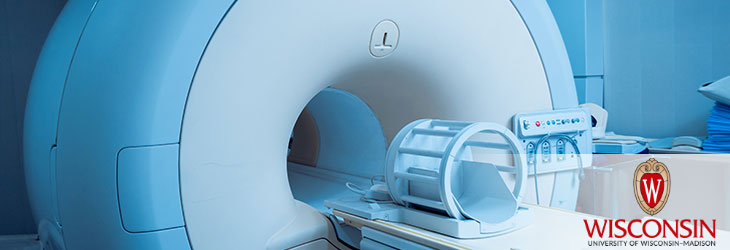Radiation Therapy

Real-Time 3-D Elastography
WARF: P140237US01
Inventors: Tomy Varghese, Atul Ingle
The Wisconsin Alumni Research Foundation (WARF) is seeking commercial partners interested in developing a method for rapidly acquiring 3-D elasticity reconstructions for use in ablation therapy.
Overview
Elastography is a type of imaging technique that reveals the stiffness of tissues. It commonly is used to detect tumors and other abnormalities that cause changes in local tissue stiffness. Measurements can be output as values or displayed as an image.
The stiffness values or maps produced in this way can be utilized to monitor radiofrequency (RF) or microwave ablation. During ablation—when an electrode is inserted into tissue to kill tumor cells—ultrasound data can be used to produce 3-D elasticity images of the hardened lesion. However, the process can be time-consuming, especially when multiple images must be obtained at each location.
UW–Madison researchers previously developed a reconstruction technique, dubbed SOUPR, for rapid 3-D elasticity imaging using limited data (see WARF reference number P130117US01). In their technique, a probe sends an ultrasonic beam of energy into tissue and receives echoes from the displaced material. Ultrasound data is acquired over a set of planes. A computer receives the ultrasound data, determines elasticity and generates a 3-D reconstruction.
The stiffness values or maps produced in this way can be utilized to monitor radiofrequency (RF) or microwave ablation. During ablation—when an electrode is inserted into tissue to kill tumor cells—ultrasound data can be used to produce 3-D elasticity images of the hardened lesion. However, the process can be time-consuming, especially when multiple images must be obtained at each location.
UW–Madison researchers previously developed a reconstruction technique, dubbed SOUPR, for rapid 3-D elasticity imaging using limited data (see WARF reference number P130117US01). In their technique, a probe sends an ultrasonic beam of energy into tissue and receives echoes from the displaced material. Ultrasound data is acquired over a set of planes. A computer receives the ultrasound data, determines elasticity and generates a 3-D reconstruction.
The Invention
The researchers have now developed an enhancement to their technique that works especially well with a 2-D ultrasound array to provide real-time 3-D imaging. The improvement derives from a new reconstruction scheme that uses sparse data.
The new scheme imposes two key requirements – interpolation and smoothing. Essentially, raw ultrasonic echo data is acquired over many imaging planes. Then, an efficient algorithm tracks frame to frame displacement of the underlying tissue at each pixel in the imaging plane. Mechanical properties such as strain can be estimated by a calculation along the ultrasound scan line direction. The 3-D reconstruction algorithm rapidly reconstructs a complete 3-D visualization from a sparse collection of scattered data points.
The new scheme imposes two key requirements – interpolation and smoothing. Essentially, raw ultrasonic echo data is acquired over many imaging planes. Then, an efficient algorithm tracks frame to frame displacement of the underlying tissue at each pixel in the imaging plane. Mechanical properties such as strain can be estimated by a calculation along the ultrasound scan line direction. The 3-D reconstruction algorithm rapidly reconstructs a complete 3-D visualization from a sparse collection of scattered data points.
Applications
- Elastography software; especially suited for 2-D ultrasound arrays
- Interventional procedures like RF ablation
- Vascular imaging
- 3-D visualization of other important tissue properties (e.g., shear wave velocity, shear stiffness, Young’s modulus, temperature, etc.)
Key Benefits
- Works in real time, even for 3-D grids with millions of grid points
- Enables fast imaging in specific regions of interest, rather than waiting until all the data is collected
- Solves a complete 3-D visualization problem in one sweep
Stage of Development
The researchers have results for studies on simulated data as well as data acquired using a tissue-mimicking phantom.
Additional Information
For More Information About the Inventors
Related Technologies
For current licensing status, please contact Jeanine Burmania at [javascript protected email address] or 608-960-9846
- WARF reference number P130117US01 describes the researchers’ SOUPR technique for faster elasticity imaging using limited data.
- WARF reference number P02153US describes a method for monitoring RF ablation via quasi-static elastography.
- WARF reference number P09030US describes a method for monitoring RF ablation via ultrasonic imaging to assist in minimally invasive ablation.